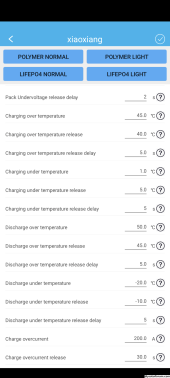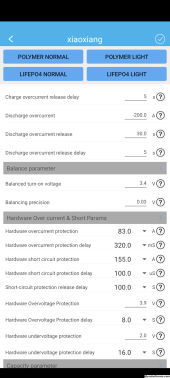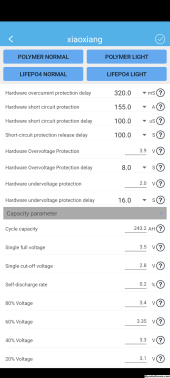Super excited that I finally got my battery assembled and BMS hooked up! This was a pretty intimidating undertaking but there's so much good information on this forum that helped me figure it out! I'm getting ready to do my capacity test but I want to get my BMS fully configured for my 4s 304Ah 12V pack. I read through quite a few posts for the settings and think I've gotten most everything but just want another set of eyes before I run my test!
Question 1: Do I need to calibrate the voltage in the Xiaoxiang app?
I top balanced all the cells in parallel with a 10A supply. I set the voltage on the supply to 3.58V as I was reading 3.65V on my multimeter (#1). I reassembled the pack in series and connected the BMS to prepare for the capacity test. When I first connected the pack the Xioxiang app read ~3.581-3.583V/cell and the multimeter read 3.63-3.64V/cell.
My present voltage readings:
Thoughts on calibration?
Question 2: Could someone look at my settings and let me know if I'm missing anything?




Question 1: Do I need to calibrate the voltage in the Xiaoxiang app?
I top balanced all the cells in parallel with a 10A supply. I set the voltage on the supply to 3.58V as I was reading 3.65V on my multimeter (#1). I reassembled the pack in series and connected the BMS to prepare for the capacity test. When I first connected the pack the Xioxiang app read ~3.581-3.583V/cell and the multimeter read 3.63-3.64V/cell.
My present voltage readings:
| Cell # | Xiaoxiang App Voltage | Multimeter #1 Voltage (~7 yr old) | Multimeter #2 Voltage (>10 yr old) |
| 1 | 3.569 | 3.612 | 3.59 |
| 2 | 3.569 | 3.612 | 3.59 |
| 3 | 3.568 | 3.611 | 3.59 |
| 4 | 3.575 | 3.616 | 3.60 |
Thoughts on calibration?
Question 2: Could someone look at my settings and let me know if I'm missing anything?







